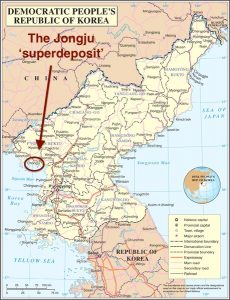Memo #258
By Marie-Pier Baril – mariepier.baril [at] gmail.com
 Earlier this month, MiningWeekly announced the world’s largest known single reserve of rare earth elements (REE) was discovered in Jongju, North Pyongan province, Democratic People’s Republic of Korea (DPRK, or North Korea). The DPRK’s mineral resources have always been substantial, but the discovery of such rare earth elements and in such quantities raises the ante because of their high demand and scarcity.
Earlier this month, MiningWeekly announced the world’s largest known single reserve of rare earth elements (REE) was discovered in Jongju, North Pyongan province, Democratic People’s Republic of Korea (DPRK, or North Korea). The DPRK’s mineral resources have always been substantial, but the discovery of such rare earth elements and in such quantities raises the ante because of their high demand and scarcity.
Comprising seventeen elements of the periodic table, REEs are essential in the production of computers, magnets, wind turbines and missile weapons systems. Being such critical commodities, there is a continuous push/pull by REE producers and consumers for their increased mining and expanded recycling. Currently, China has a quasi-monopoly over the extraction and export of this highly strategic resource, but since 2010, Beijing has established quotas on their export, claiming it to be a measure meant to consolidate their domestic industry and implement tougher environmental regulations (the extraction of REEs can be highly polluting, and to date remains very unregulated in China). However, the United States, Japan and the EU have accused China of playing the resource nationalism card, and filed a dispute claim with the WTO. Such regulation has also made the North Korean deposit that much the weightier.
The discovery of such large REE reserves in North Korea carries many implications. For one, it could revitalise the North Korean mining industry as well as its domestic economy. Pyongyang could also use these highly strategic minerals for the manufacture of their own high tech goods, to include the production of weapons systems for domestic use or export. Yet, to do any of this the DPRK will need to improve its infrastructure and expertise. This could play into the hands of China, which happens to be both a leader in the field of REE mining and North Korea’s neighbour and closest ally. On the other hand, Pyongyang could choose to sell this resource abroad in order to gain much-needed hard currency. In fact, the Pacific Century Rare Earth Minerals, Ltd., a Virgin Islands-based partnership between the Korea Natural Resources Trading Corporation and a private equity firm, just received a twenty-five year license to mine the Jongju deposit, though what will be done with the mined resource is still not clear. In any event, how the REEs are exploited and to what end is sure to have far-reaching ramifications.
About the Author:
Marie-Pier Baril is a second year student in the Master of Arts – Asia Pacific Policy Studies (MAAPPS) program at the University of British Columbia.
- “Largest Known Rare Earth Mineral Deposit Discovered,” MiningWeekly, December 2013
- “Rare Earth’s Bankroll North Korea’s Future,” Leonid Petrov, August 2012
- “The Mining Industry of North Korea,” Nautilus Institute, August 2011
- “Rare Earth Elements: The Global Supply Chain,” Congressional Research Service, December 2013
Related Memos:
- See our other memos on North Korea.

[…] on December 20, […]